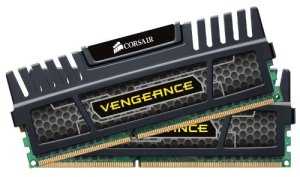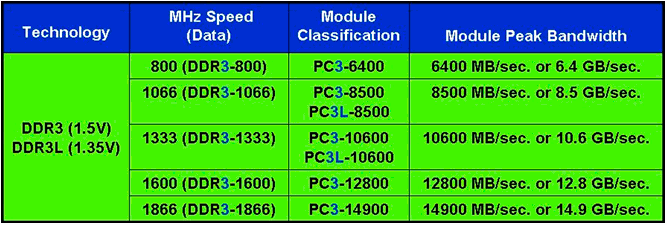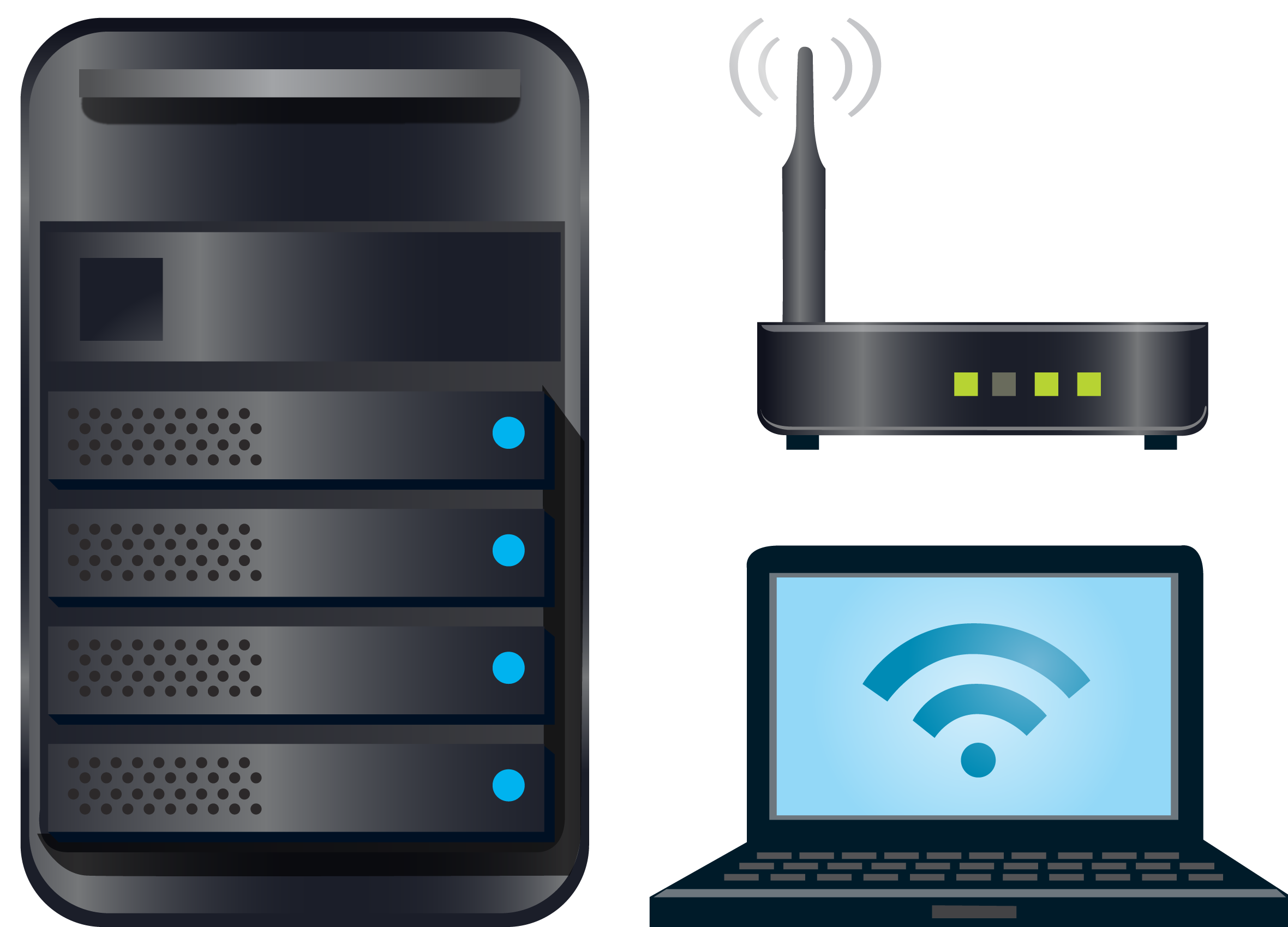What is DDR3L?
DDR3L is a special type of DDR3 RAM where the letter ‘L’ refers to low voltage standard. DDR3L uses just 1.35V, which is 0.15V lower than what is used in DDR3. The advantage of working under a low voltage is that the power consumption is low. The less power consumption means a better battery life can be achieved. Because of this DDR3L is mostly used in mobile devices such as laptops and embedded devices rather than in PCs. An added advantage of low power consumption is less heat generation, which is again useful for compact mobile devices. The other specifications such as memory density, frequencies and the protocols are same as in DDR3. DDR3L RAM is generally available as SO-DIMM modules that are 67.5 mm having just 204 pins rather than longer DIMM modules. Reason is that DDR3L is targeted for mobile devices and they have SO-DIMM slots.
DDR3 vs DDR3L
The DDR3L is a newer version of DDR3 RAMs, where “L” stands for “Low-voltage level”. Its because DDR3L requires less voltage than DDR3 memories. DDR3 memory operates at 1.5V in general, whereas DDR3L operates at 1.35V, and reduces power consumption by 15% compared to DDR3 RAMs. These voltage values determine power consumption and play vital roles in overclocking RAM. DDR3L memory operates with PC3L modules, where DDR3 ones operate with PC3 modules.
Battery Life
newer memory versions operate at lower voltage levels to reduce power consumption. In laptops or notebooks, this can greatly affect battery life. DDR3U is an “Ultra-low voltage level” DDR3 memory, which operates at 1.25V, much less than DDR3 and DDR3L memories. The transfer rates of these are the same.
Benefits Of DDR3
Please enable JavaScript
Benefits Of DDR3
Supported Processor Type
DDR version compatibility also affects processor type. The DDR3 memory is compatible in the previous generation of Intel processors, but DDR3L is only supported from 3rd generation processors. After the 5th gen, there are no processors compatible with DDR3 memory. Only DDR3L and DDR4 support can be found at these ranges.
Backward Compatibility
Backward compatibility means compatibility with any previous versions or legacy systems. It is also known as “Downward compatibility”. DDR3 memory isn’t backward compatible, but DDR3L memory is. This means you can’t use DDR3 memory with another DDR2 memory. But you can use DDR3L memory with another DDR3 memory. They are interoperable, and therefore DDR3L is a backward compatible memory.
However, using a DDR3L memory with another DDR3 memory will cause both of these memories to run at 1.5V instead of 1.35V of DDR3L.
If you are still confused which one to choose, here’s a comparison table for you.
| DDR3 | DDR3L | |
| Voltage | 1.5 | 1.35 |
| Power Usage | High | Less |
| Heat Generation | High | Low |
| Max Capacity | 8 GB | 8 GB |
| Price | Low | High |
Benefits of Getting DDR3L
DDR3L is an advanced version of memory. So, it comes with certain pros or advantages. Both DDR3 and DDR3L memory runs at the same clock speed. But the advantages are significant:
- DDR3L operates at a lower voltage (1.35V). So, they consume 10% less power to operate than DDR3 ones.
- For less power consumption, DDR3L memory gives better battery life for laptops than DDR3.
- DDR3L is backward compatible, making it easier to use with other versions.
- Here, less voltage shift is needed in transition from 0 to 1, making the performance better than DDR3 within the same clock speed.
Benefits of Getting DDR3
- As an older model, DDR3 memory is much cheaper than DDR3L ones.
- DDR3 memory is compatible with a wider and older generation of processors.
- These memories are largely available in the market, as opposed to the DDR3L models which are rare.
- The data transfer rate of DDR3 and DDR3L memory is quite the same.
What is DDR3?
DDR3, which stands for Double Data Rate Type 3, is a type of Dynamic Random Access Memory (DRAM), which came as the successor of DDR and DDR2. It was released to the market in 2007 and today most computers and laptops in the market use DDR3 as the RAM. The voltage specification for DDR is 1.5 V and, therefore, it consumes very less power when compared to its predecessors DDR and DDR2. DDR3 standard allows chips up to capacity 8 GB. DDR3 RAM are available for different frequencies such as 800, 1066, 1333, 1600, 1866, 2133 MHz. A DDR3 RAM module used for personal computers has 240 pins and the length is 133.35 mm. The DDR3 modules used on laptops are called SO-DIMM and its length is much smaller with a length of 67.6 mm and less number of pins, which is 204 pins.

Как различить и совместимость
Чтобы верно определить, к какому стандарту относится модуль, нужно знать чем отличается DDR3 от DDR3l. Разберемся в чем разница между DDR3 и DDR3l с точки зрения маркировки.


На модулях DDR3, как правило, присутствует маркировка PC3, тогда как на низковольтной памяти ставится PC3L. Кроме того, в некоторых случаях указывается и напряжение питания, 1,5v для ддр3 и 1,35v для ддр3л соответственно.

Из-за одинакового форм-фактора и расположения ключа, можно вставить модуль DDR3 в разъем на материнской плате, рассчитанной на DDR3L, или наоборот. К чему может привести подобная невнимательность?
Если модуль памяти рассчитан на напряжение в 1,5 вольта, а получает только 1,35 вольта, то, весьма вероятно, он будет вести себя нестабильно, становясь причиной регулярных зависаний и внезапных перезагрузок системы. Впрочем, вполне возможна ситуация, когда планка ОЗУ будет нормально работать. Особенно если немного повысить тайминги и снизить частоту, тогда шанс на бесперебойную работу увеличится, пусть и ценой некоторого снижения быстродействия. Но стоит ли рисковать?
Казалось бы, достаточно поднять напряжение, ведь многие материнские платы позволяют это. Да, тогда получится ситуация вполне типичная для разгона, когда для нормальной работы приходится повышать напряжение.
Стоит отметить, что процессоры intel, начиная с поколения Skylake, рассчитаны только на работу с низковольтной DDR3l памятью. По утверждению представителей компании, в долгосрочной перспективе работа процессоров 6 и более поздних поколений архитектуры Core с памятью рассчитанной на напряжение 1,5 вольт, может навредить CPU.
Получается, что заставить работать модуль DDR3 с системной платой и процессором, рассчитанными на DDR3l, во многих случаях можно. Но, в результате всех предпринятых усилий легко получить нестабильно работающий компьютер. Память DDR3 сложно считать универсальным решением для любой конфигурации, чем она также отличается от DDR3l.
Лучшим способом приобрести нужную память, это открыть свой ноутбук, достать модуль памяти и списать его характеристики или взять его в магазин. Так же можно воспользоваться ПО для просмотра аппаратной начинки компа (типа CPU-Z) и зайти во вкладку SPD.
Второй вариант — использование модуля, рассчитанного на низкое напряжение, в старой материнской плате, поддерживающей DDR3. Исходя из требований JESD79‐3‐1A.01, документа, в котором регламентирован стандарт DDR3L, любой модуль должен быть обратно совместим со обычным DDR3.
Which One Should You Buy?
At first, you should consider if the processor is compatible or not. Processor manufacturers publish their compatibility range on their website. Choose accordingly by checking the RAM speed beforehand. If you already have DDR3 memory, buying a DDR3L one will not take any additional effect, and both will run at the same 1.5V range. Also, stay out from hoaxes like downloading RAM from the internet.
But if you are looking to replace all your old memories, and your system is compatible, you should go with the DDR3L RAMs. Not only it will save power, but you can still use them even if you want to upgrade your processor to a newer version. It will much likely be compatible with DDR3L memories, but may not be such for DDR3 ones.
What is the difference between D DR3 and DD R3L?
• DDR3L is a special type of DDR3 where L refers to low voltage standard.
• DDR3 needs a voltage of 1.5V while DDR3L needs only 1.35V.
• DDR3L consumes less power than DDR3.
• DDR3L generates less heat when compared to DDR3.
• DDR3L is mostly used in mobile devices such as laptops and embedded devices while DDR3 is mostly used in personal computers. However, the re are mobile devices, which use DDR3 as well.
• The market price of a DDR3L module is higher than the market price of a DDR3 module.
| DDR3 | DDR3L | |
| Name | Double Data Rate Type 3 | Double Data Rate Type 3 Low Voltage Standard |
| Voltage specification | 1.5 V | 1.35 V |
| Power Consumption | High | Less |
| Heat generation | High | Less |
| Memory Density | Up to 8GB | Up to 8GB |
| Supported Frequencies | 800, 1066, 1333, 1600, 1866, 2133 MHz | 800, 1066, 1333, 1600, 1866, 2133 MHz |
| Number of Pins | 240; SO-DIMM – 204 | SO-DIMM – 204 |
| Length | 133.35mm; SO-DIMM – 67.6mm | SO-DIMM – 67.5mm |
| Price | Low | High |
| Usage | Personal computers, Laptops, servers | Laptops, Mobile devices, Embedded systems |
Summary:
Выводы
В случае с DDR3 памятью и материнской платой поддерживающей низковольтную память, теоретически, можно заставить работать любую память в любой материнской плате, если немного поэкспериментировать с напряжением, частотами и таймингами. Но, лучше использовать именно ту память которая рекомендована для материнской платы и процессора. Так можно сэкономить немало времени и нервов и заниматься за компьютером тем, чем планировалось. А сборку и тестирование нестандартных конфигураций лучше оставить энтузиастам-оверклокерам.Модули DDR3l можно использовать в системных платах рассчитанных на любые типы DDR3.





















